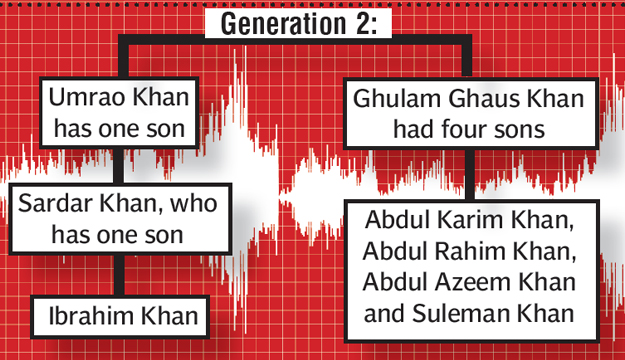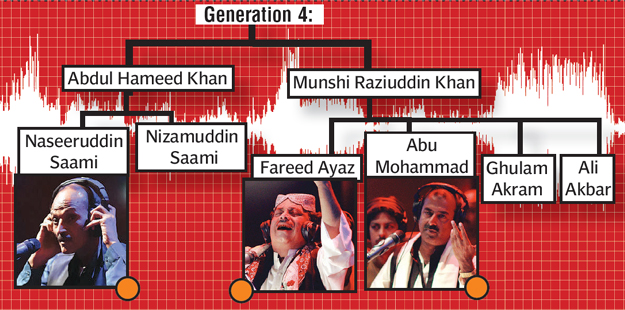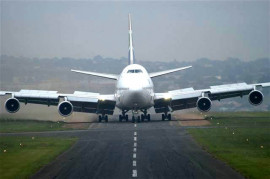
Qawwali has been around longer than rock but these two genres share so much verve. You could feel the head-banging come on to the guy with the extended bootlegged version of Jimi Hendrix’s hair in the front row. That was when everyone knew Hamza Akram had hit the sweet spot.
The 21-year-old delivered a blood-thumping performance with his ‘party’ at the Pakistan American Cultural Centre in Karachi on April 30 to test the waters with their ‘Sufystical’ blend of Qawwali and rock. The new-fangled name for their interpretation of fusion is too clever to stick but its sound is dead on.
Anyone who was in that auditorium that night knew this young man had quickened their pulse in the way that only one other had done before. But if you mentioned that name to Hamza Akram he would likely blush. The weight of his musical lineage is four generations heavy and he is only too aware of it.
But in the body-still preparatory pause before he opens his mouth, you can tell Hamza is finally getting his groove on. He is the face of the next generation of shudh traditional Qawwali and is being trained by none other than his uncles Fareed Ayaz and Ustaad Naseeruddin Saami.
Cradle to chord
All your stereotypes about the homes of qawwals are correct. From the day they are born, their children eat, sleep, breathe music. Any other profession is unthinkable.
But even in a household whose bread and butter is about the other world, Darwinian evolution rings as true as it does in ‘normal’ ones. It is the ‘fittest’ child who is chosen to lead the pack.
“Whenever he was teaching his students, my grandfather Munshi Raziuddin would single me out and make me sit there if only to observe,” says Hamza. “Sometimes I would go to sleep listening to them perfect that one note for hours.”
Today his party consists of eight young scions of the Qavvaal Bachon ka Gharana of Delhi, including Hamza’s own brothers and the sons of his uncles, the famed qawwals Fareed Ayaz and Abu Mohammad.
“I was selected to lead the group by Fareed Ayaz,” he says. Just Fareed Ayaz, no chacha, taya or other deferential references, because the great qawwal is now his teacher and there is no space to invoke a family connection. It’s all about the hours of hard work required to master the art that has been handed down 750 years, and is considered almost sacred.
Practice, practice
Hamza wasn’t always a clear choice though. “Everyone would make fun of me whenever I tried to sing,” he says. “My brothers and uncles were capable of creating such a powerful sound. I, on the other hand, had a terrible voice.”
It didn’t help that Fareed Ayaz would make it a point to chastise Hamza every time he made even the slightest mistake during a performance. “Sometimes I would be really embarrassed because I felt the audience could see him scolding me,” he adds.
But his father Ghulam Akram, who is also part of the Fareed Ayaz & Abu Mohammad group, would pacify him. He would tell the dejected young man to consider himself lucky that Fareed Ayaz was paying such special attention to him.
But it would take much more to convince Hamza that he was going to be able to make the grade. His confidence level was at an all-time low in 2005, following what he calls his worst performance ever. The All Pakistan Music Conference in Karachi had organised a competition for about 350 child musicians. Given his lineage, Hamza was asked to come for an audition.
Hamza went running in a panic to his uncle Ustaad Naseeruddin Saami who taught him Jaagi main teray kaaran saari saari ratian in a Raag called Kalavati. Jaan, as Saami’s pupils refer to him, broke it down for him note by note.
Unfortunately, the 13-year-old did little to squawk out the number. “I was selected only because there were others who were worse than me!” Hamza says candidly. After the audition, one of the musicians beckoned to him. He asked him if he was really Munshi Raziuddin’s grandson. When Hamza said he was, the musician replied: ‘Woh to kabhi aisa na gaatay’ (He would never sing like that). “I wanted to die and I cried inconsolably when I got home,” says Hamza. “My father kept asking me what on earth had happened. And I told him I was a complete failure.”
It was only two years later, by 2007, when Hamza hit 15 that he began to receive formal training in both qawwali, under Fareed Ayaz, and eastern classical music, under Saami. In a small ceremony Hamza became the ganda bandh pupil of the two ustads who tied a red thread around his wrist which he continues to proudly wear today.

Hamza loves AR Rehman and was greatly disappointed that he couldn’t go with Fareed Ayaz to Stanford University where the qawwal was collaborating with the Indian artist. PHOTO ATHAR HUSSAIN
Saami would make him work on sustaining one note for three, sometimes even four, hours. Practice involved making a sound like gargling and holding it for even longer.
While Fareed Ayaz, in a typical otherworldly fashion, would dismiss all talk of dietary restrictions, Saami told Hamza to stop eating rice and drinking cold water and soft drinks. “One day, I went over for practice after having cheated the night before,” recalls Hamza. Saami spotted it immediately and Hamza had to confess he had been unable to resist his mother’s biryani for dinner. But instead of chastising the young singer, Saami told him to know when to break the rules. For what if he went to a performance where they were serving nothing but rice? He could never become too choosy.
The qawwal boot camp involved two hours with Saami every day and then performing and training for four hours during performances every night with Fareed Ayaz. “Since Qawwali is such an energetic form of music, it would wear my throat muscles out. When I would wake up in the morning and try to speak, my voice would be unrecognizable,” Hamza says. Saami advised him that in order to counter this he should start each day before breakfast by practicing his root note — the one most natural to his voice — with the harmonium for half an hour.
Saami then increased his training to five hours a day that was supplemented by four in performances in the evening with the rest of the party. Eventually his vocal chords strengthened enough to do the heavy-duty lifting needed every night. “It is true that when he came to me, he had no knowledge,” Ustad Naseeruddin Saami told The Express Tribune. “But in our world, we judge a potential student not on his current ability but on his potential.” In Hamza, he spotted that and courage to pursue his passion. “I have high hopes from him. I see him as becoming a force in both classical music and Qawwali.”
The past and future
In 2011, Hamza performed himself for the first time in a qawwali to commemorate the death anniversary of Munshi Raziuddin. Everyone in the audience knew that a star was born, but what made Hamza’s day was Fareed Ayaz’s succinct but all-encompassing acknowledgment of his grit, determination and talent. “Thank God for this performance. Tumhein ghairat aagayi,” Hamza quotes Ayaz as telling him that night.
For Fareed Ayaz, the rules are simple: the more you learn, the more you get. “I chose Hamza because he is capable of achieving it,” he told The Express Tribune. “I know that he has both the passion and the ability to take our legacy forward. He has my full blessing.”

Like other families organise barbeque dinners, Hamza’s family holds the Khandani Jalsa three to four times every year. Every man performs a pure classical solo, starting from the youngest all the way to the eldest. On the 29th of Ramazan, the family organises the jalsa to pay tribute to Ustad Tanras Khan, the fountainhead of the family, on his death anniversary. PHOTO ATHAR HUSSAIN
Since then, Hamza has matured (exponentially). But he has learnt well at the feet of his masters and is devoid of hubris. For example, he admits that he continues to find it difficult to perform Man Kunto Maula. “It has a specific flavour of Raag Bhopali and that has to be delivered the way it needs to be done,” he explains. “And I am sure you will agree that no Qawwali is complete until Man Kunto Maula is performed well!”
While he knows he will be a qawwal all his life, Hamza isn’t one to stick to tradition so religiously that he forgets to stay in tune with changing times. Two years ago, he enrolled to study Western Theory with keyboardist Leonard Massey at the National Academy of Performing Arts in Karachi to learn the Western equivalent of Eastern musical notes.
“Hamza spent little time with me, but it is amazing how much he was able to learn because of his will to absorb as much knowledge as he can,” Massey says. “He coped quickly, and even learnt how to read and write Western musical notes. I feel that Qawwali is in his blood, and it is his strength.”
Hamza feels this training gives him an advantage when performing internationally with foreign musicians. “My ancestors did not know what World Music was,” he humbly explains. “All they ever did was Sa Re Ga Ma Pa Dha Ni Sa. Now is the time to move beyond that.”
As Hamza’s PACC performance of his blend of fusion ‘Sufystical’ proved, he has the found the beginnings of a formula which was popularized by the great Nusrat Fateh Ali Khan. “But it was never considered a genre,” says Hamza. “I want to establish it as one.”
If anything, it will be a spiritual and worldly journey in which this young qawwal will have to learn to walk the middle ground that straddles experiment and tradition. In order to remain grounded, though, he carries with him a couplet Fareed Ayaz gave him:
Apni mitti pe hi chalne ka saleeqa seekho
Sang-e-mar mar par chalo ge to phisal jao gay
From Amir Khusrau to Hamza Akram
Once upon a time, three notes led to embarrassment in the darbar of Allauddin Khilji (1296–1316), the second ruler of the Turko-Afghan Khilji dynasty in India.
A performer from Karnataka by the name of Gopal Naik had come to the court with 900 pupils and sang a 28-line song in Sanskrit for Khilji. He then asked the ruler if there was a Muslim cultural equivalent.
Khilji was embarrassed. The Muslims had only three notes at that time. A meeting was called, and someone suggested that help be sought from Abul Hassan Jameeluddin Amir Khusrau, a special mureed of Hazrat Nizamuddin Aulia who was a musical genius. The king approached Aulia, seeking Khusrau’s help in the matter.
Aulia ordered Khusrau to create a response to Naik’s incredible music. Khusrau, unable to say no to his pir, asked for six months. He then selected 12 men who were known to have beautiful voices and called this team the ‘Qawwal Bachon ka Gharana’. It was led by Saamat bin Ibrahim, a physically impaired man who is said to have begun to hear and speak after a miracle performed by Aulia.
After listening to the response that the Qawwal Bachon ka Gharana presented, Gopal Naik was so impressed that he declared he wanted to become a Muslim. He was converted by Saamat, who became the founder of the Qawwal Bachon ka Gharana.
Saamat’s family continued to work in music, but it was only in the 1800s that the next big name of the lineage, Ustaad Tanras Khan, emerged. He was asked to teach music to Bahadur Shah Zafar and was gifted the Chandni Mahal on Tanras Street, that continues to stand in Old Delhi today. With Tanras Khan, the family’s name was changed to Qawwal Bachon ka Dilli Gharana. Tanras Khan was Hamza Akram’s great, great, great grandfather (see family tree).





The agony and the ecstasy
The Way of the Sufi

The late Idries Shah’s 1970 follow-up to his book The Sufis has been hailed by the New York Times and is considered an excellent introduction to the subject. It contains the biographies of the Sufis and has extensive notes at the back. New York: E. P. Dutton, 1970
Sufi Music of India and Pakistan: Sound, Context, and Meaning in Qawwali

Regula Burckhardt Qureshi walks you through all aspects of qawwali, from the textual message to the proper procedure and setting. It contains the helpful transliteration of verse and their English translations and is full of photographs. Considered a classic. Unfortunately out of print, according to OUP.
London: Cambridge University Press, 1986
Khayal Darpan - A Mirror of Imagination

Delhi-based filmmaker Yousuf Saeed explores the impact of India’s Partition on the classical music traditions of Pakistan in his musical documentary film, Khayal Darpan. He travels across the country to interview musicians and scholars, attend music concerts and to observe the teaching of this beautiful art.
Published in The Express Tribune, Sunday Magazine, May 12th, 2013.
Like Express Tribune Magazine on Facebook to stay informed and join the conversation.
COMMENTS (5)
Comments are moderated and generally will be posted if they are on-topic and not abusive.
For more information, please see our Comments FAQ

1731476617-0/Sandra-Oh-(2)1731476617-0-165x106.webp)















What a wonderful article! Incredible work!
What a treat! Great piece of writing on a great genre of music.
Amazing article. Wish we had more of such stuff from ET. Btw the charts in red behind the qawwal's family tree, are those their pitch ranges?
Superb write-up. Really enjoyed that.